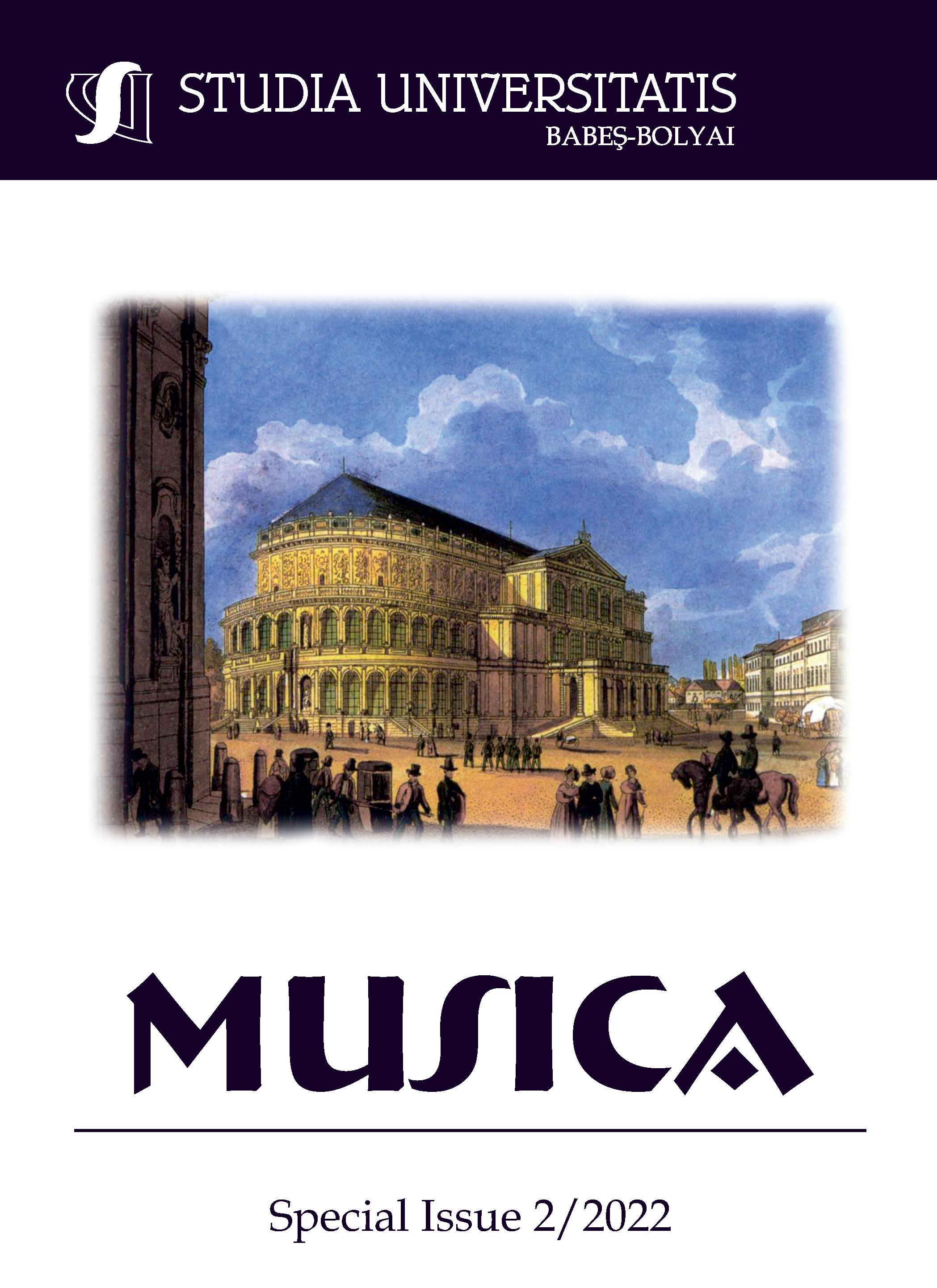IN SEARCH OF “THE MORE IMPORTANT” IN STRING QUARTET NO. 1 BY DIETER ACKER
DOI:
https://doi.org/10.24193/subbmusica.2022.spiss2.13Keywords:
Dieter Acker, String Quartet No. 1, Sigismund Toduță, Anton Webern reception, PalindromeAbstract
Dieter Acker’s String Quartet No. 1 represents a turning point in the composer’s output, being an opus composed in his last year of study in Sigismund Toduță’s composition class (1964) and one which brought him international recognition, winning second prize at the 1966 Prague Spring International Festival. This study presents biographical, historical, and analytical aspects of the work which are reflected in its musical structure, revealing both a respect for the historical tradition of past centuries and the search for new orientations of the musical avant-garde. Through arguments related to the biography of the young Dieter Acker, trained under Franz Xaver Dressler and Sigismund Toduță, the study presents the unity of meaning and content that is directly reflected in String Quartet No. 1.References
Acker, D. (1968). Un discipol din Sibiu al lui Schönberg: Norbert von Hannenheim (A Disciple of Schoenberg in Sibiu: Norbert von Hannenheim). Lucrări de muzicologie 4: 175-188.
Acker, D. (1969). Norbert von Hannenheim. Melos 1: 6-8
Acker, D. (1966). Trăsături ale creației vocal-instrumentale a lui Webern (Features of Webern’s vocal creation). Muzica 5: 36-40.
Acker, D. (1967). Un manuscris transilvănean din secolul XVII: „Neu-Musicalische Concerten” de Gabriel Reilich (A Transylvanian Manuscript from the 17th Century: „Neu-Musicalische Concerten” by Gabriel Reilich). Lucrări de muzicologie 3: 153-170.
Acker, D. (1979). Hannenheim, Norbert Wolfgang Stephan von. In Fr. Blume (ed.), Die Musik in Geschichte und Gegenwart. Allgemeine Enyzklopädie der Musik 16. Kassel – Basel – Paris – London – New York: Bärenreiter: 588 589.
Acker, D. (2011). Maestrul Toduță în amintirea unui discipol din München (Maestro Toduță in the Memory of a Disciple from Munich). Lucrări de muzicologie 26(1): 5-10.
Cooper, K., and Höpfner, Th. H. (1996, rev. 2016). Intermezzo (Instrumentalsatz) (Intermezzo (Instrumental)). MGG Online, https://www.mgg-online.com/
article?id=mgg20005&v=1.0&rs=id-b9198e1e-9b2d-4525-e3f0-69206be2f330&q=intermezzo, accessed on 17 July, 2022.
Křenek, E. (1952). Zwölfton-Kontrapunkt-Studien (Study of Twelve-tone Counterpoint), Mainz, B. Schott’s Söhne.
Krones, H. (2007, rev. 2016). Webern, Anton Friedrich Wilhelm. MGG Online, https://www.mgg-online.com/article?id=mgg13669&v=1.0&rs=id-ca02b08d-7630-7666-f97d-cf0dd3a4e4a9&q=palindrom, accessed on 25 August, 2022.
Mielke-Gerdes, D. (1998, rev. 2016). Sonate 20. Jahrhundert (Sonata 20th Century). MGG Online, https://www.mgg-online.com/article?id=mgg16076&v=1.0&rs=
id-98a55f97-99f2-28a2-a0d0-d3bc67c9f60c&q=sonate, accessed on 14 July, 2022.
Möller, H. (1995, rev. 2016). Goldener Schnitt (Golden Ratio). MGG Online, https://www.mgg-online.com/article?id=mgg15434&v=1.1&rs=id-e3be402b-330e-0c07-9247-278ac082c49a&q=fibonacci, accessed on 25 August, 2022.
Niculescu, Șt. (1965). Anton Webern. Muzica 4: 29-36.
Niculescu, Șt. (1980). Anton Webern. Reflecții despre muzică, Bucharest, Editura Muzicală: 208-223.
Popovici, D. (1967). Prefață (Preface). Dieter Acker, Cvartetul de coarde nr. 1, Bucharest: Editura Muzicală: 3-4.
Sandu-Dediu, V. (2017). Înainte și după neoclasicism: Max Reger și Wilhelm Georg Berger (Before and after Neoclassicism: Max Reger and Wilhelm Georg Berger). Încăutarea consonanțelor, Bucharest, Humanitas: 46-59.
Sandu-Dediu, V. (2016). Murky Times and Ideologised Music in the Romania of 1938-1944. Musicology Today 27: 193-214
Sandu-Dediu, V. (2006). Rumänische Musik nach 1944 (Romanian Music after 1944), Saarbrücken, Pfau-Verlag.
Schmitt, St. (2006). Gespräch mit Dieter Acker am 19. Mai 2004 (Interview with Dieter Acker on 1 May 2004). C. Brödel (ed.), Dieter Acker. Al. L. Suder (ed.), Series Komponisten in Bayern. Dokumente musikalischen Schaffens im 20. Jahrhundert 48, Tutzing: Hans Schneider: 13-27
Stieger, Chr. (2013). Franz Xaver Dressler (1898-1981). Die Biographie (Franz Xaver Dressler (1898-1981). The Biography), München, Edition Musik Südost.
Toduță, S. (2019). Anton Webern, Variațiuni pentru pian op. 27, p. I (Anton Webern, Piano Variations Op. 27, 1st mov.). Inedite. Conferințe – interviuri, Cluj-Napoca, MediaMusica: 46-90.
Toduță, S. (1968). Ideea ciclică în sonatele lui Enescu (The Cyclic Idea in Enescu’s Sonatas). Studii de muzicologie 4: 131-159.
Türk, H.-P. (2006). Dieter Acker – Wie ich ihn sehe, wie ich ihn höre (Dieter Acker – How I see him, how I hear him). C. Brödel (ed.), Dieter Acker. Al. L. Suder, series Komponisten in Bayern. Dokumente musikalischen Schaffens im 20. Jahrhundert 48, Tutzing, Hans Schneider: 31-33.
Türk, H.-P. (1997). Mein Lehrer Sigismund Todutza (My Professor Sigismund Todutza). Teutsch, K. (ed.), Siebenbürgen und das Banat. Zentren deutschen Musiklebens im Südosten Europas. Konferenzbericht Coesfeld/Westfalen 7.-11.101995. Koch, Kl.-P, Loos, H., Winterhoff, H.-J. (eds.) series Deutsche Musik im Osten. Schriftenreihe des Instituts für Deutsche Musik im Osten zur Musikgeschichte der Deutschen und ihrer Nachbarn in Ost-, Ostmittel- und Südeuropa 9, Academia Verlag, Sankt Augustin: 101-106.
Downloads
Published
How to Cite
Issue
Section
License
Copyright (c) 2022 Studia Universitatis Babeș-Bolyai Musica

This work is licensed under a Creative Commons Attribution-NonCommercial-NoDerivatives 4.0 International License.






